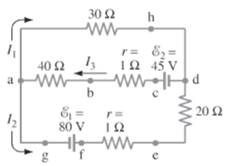
Concept explainers
(a)
The potential difference between points a and d.
(a)
Answer to Problem 25P
The potential difference between points a and d is
Explanation of Solution
Given information:
Consider the given circuit.

Formula used:
Apply Kirchhoff’s voltage law in the circuit to determine the currents.
Calculation:
Apply Kirchhoff’s voltage law in the upper loop.
Apply Kirchhoff’s voltage law in the lower loop.
At node (a), apply Kirchhoff’s current law.
Substitute the value of
and,
On solving the above equations,
Substitute the values in equation (3).
Calculate the voltage drop across the points a and d.
Substitute the value in the above expression.
Therefore, thepotential difference between points a and d is
(b)
The terminal voltage of each battery.
(b)
Answer to Problem 25P
The terminal voltage of the 45-volt battery is
Explanation of Solution
Given information:
Consider the given circuit.

Formula used:
Apply Kirchhoff’s voltage law in the circuit to determine the terminal voltage across each battery.
Calculation:
From part (a), the values of current are as follows. On solving the above equations,
Calculate the terminal voltage of 80-volt battery.
Similarly, calculate the terminal voltage of 45-volt battery.
Therefore, the terminal voltage of the 45-volt battery is
Chapter 19 Solutions
Physics: Principles with Applications
Additional Science Textbook Solutions
University Physics (14th Edition)
The Cosmic Perspective (8th Edition)
University Physics Volume 1
Physics for Scientists and Engineers: A Strategic Approach with Modern Physics (4th Edition)
Tutorials in Introductory Physics
Sears And Zemansky's University Physics With Modern Physics
 College PhysicsPhysicsISBN:9781305952300Author:Raymond A. Serway, Chris VuillePublisher:Cengage Learning
College PhysicsPhysicsISBN:9781305952300Author:Raymond A. Serway, Chris VuillePublisher:Cengage Learning University Physics (14th Edition)PhysicsISBN:9780133969290Author:Hugh D. Young, Roger A. FreedmanPublisher:PEARSON
University Physics (14th Edition)PhysicsISBN:9780133969290Author:Hugh D. Young, Roger A. FreedmanPublisher:PEARSON Introduction To Quantum MechanicsPhysicsISBN:9781107189638Author:Griffiths, David J., Schroeter, Darrell F.Publisher:Cambridge University Press
Introduction To Quantum MechanicsPhysicsISBN:9781107189638Author:Griffiths, David J., Schroeter, Darrell F.Publisher:Cambridge University Press Physics for Scientists and EngineersPhysicsISBN:9781337553278Author:Raymond A. Serway, John W. JewettPublisher:Cengage Learning
Physics for Scientists and EngineersPhysicsISBN:9781337553278Author:Raymond A. Serway, John W. JewettPublisher:Cengage Learning Lecture- Tutorials for Introductory AstronomyPhysicsISBN:9780321820464Author:Edward E. Prather, Tim P. Slater, Jeff P. Adams, Gina BrissendenPublisher:Addison-Wesley
Lecture- Tutorials for Introductory AstronomyPhysicsISBN:9780321820464Author:Edward E. Prather, Tim P. Slater, Jeff P. Adams, Gina BrissendenPublisher:Addison-Wesley College Physics: A Strategic Approach (4th Editio...PhysicsISBN:9780134609034Author:Randall D. Knight (Professor Emeritus), Brian Jones, Stuart FieldPublisher:PEARSON
College Physics: A Strategic Approach (4th Editio...PhysicsISBN:9780134609034Author:Randall D. Knight (Professor Emeritus), Brian Jones, Stuart FieldPublisher:PEARSON





